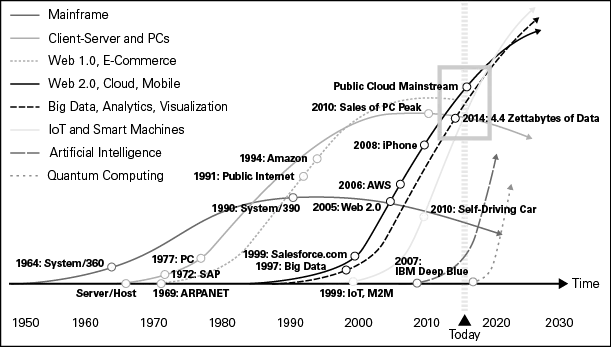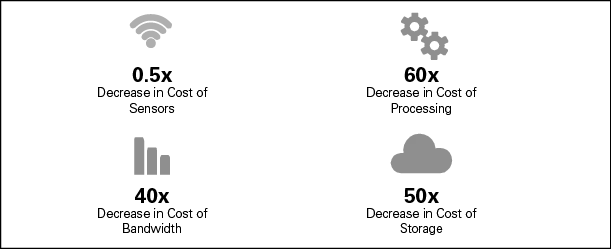
Industry X.0
Realizing Digital Value in Industrial Sectors
Eric Schaeffer
- English
- ePUB (mobile friendly)
- Available on iOS & Android
Industry X.0
Realizing Digital Value in Industrial Sectors
Eric Schaeffer
About This Book
Industry X.0 takes an insightful look at the business impact of the Internet of Things movement on the industrial sphere. Eric Schaeffer combines deep analysis with practical strategic guidance, and offers tangible and actionable recommendations on how to realise value in the current digital age. Based on extensive research and insights into the six core competencies that have been identified by Accenture, Industry X.0 explores critical aspects of the Industrial Internet of Things (IIoT), discussing and defining them in an engaging and accessible manner. These include managing smart data, handling digital product development, skilling up the workforce, mastering innovation, making the most of platforms and ecosystems, and much more. Meticulously researched and clearly explained, Industry X.0 makes a stringent case for companies to actively shift mind-sets away from products, towards services, value and outcomes. Complemented by a wealth of case studies and real world examples, this book provides invaluable, practical 'how-to' advice for business organizations as they embark on their journeys into the era of the IIoT.
Frequently asked questions
PART I
The Industrial Internet of Things – Transforming Manufacturing Beyond Recognition
01
Industry’s Ongoing and Accelerating Digital Transformation

The Drivers of Change in the Industrial Sphere

Technology Becomes Affordable and Puts Speed Behind the IIoT

Table of contents
- Cover
- Title Page
- Contents
- Preface
- Acknowledgments
- Introduction
- PART I The Industrial Internet of Things – Transforming Manufacturing Beyond Recognition
- 01 Industry’s Ongoing and Accelerating Digital Transformation
- The Drivers of Change in the Industrial Sphere
- Technology Becomes Affordable and Puts Speed Behind the IIoT
- The Value of the IIoT is Still to be Unlocked
- Ecosystems Form Powerful Wells of Innovation
- The Product of Me vs. Mass Manufacturing
- Liquid Fulfillment Networks Will Supplant Old-Style Factories
- The Critical Importance of Preparing the Digital Workforce
- The Surprisingly Slow Embrace of the IIoT by Business
- Takeaways
- 02 How the IIoT Leads to the Outcome Economy
- New Tech Creates New Business Models
- Living Products or the Reinvention of the Product
- Outcome Orientation Spurs Innovation in Products and Services
- Outcomes are Appearing Across Sectors
- The Why Behind the Buy
- From Rigid Business Silos to Agile Ecosystems
- New Risks and Rewards
- The Four Future Stages of Industry
- Takeaways
- 03 Digital Super Value – A Guiding Light for Digital Strategy
- Two Speeds Create Massive Value Deposits
- The Societal Benefits
- What’s in it for Business?
- Automotive – the Vanguard Efficiency Seekers
- How to Find the Right Pivots
- Takeaways
- PART II How to Make the Most of the Digital Industrial Transformation
- 04 Six “No-Regret” Capabilities – the Journey Towards Digital, Mapped out Simply
- From Old World to New World on Many Different Paths
- Be Adaptive and Relaxed but Curious and Visionary – and Get Going
- Design Thinking Speeds up Service Development Processes
- The Six Fundamental Capabilities that Can Get your Digitization Started
- Your IIoT Business – How to Succeed
- To Take Services to Market, Think Big, Start Small, Scale Fast
- Takeaways
- 05 Zoom in: How to Make Data Analytics Work Your Way
- Raw Data Has no Value and Needs Enrichment
- Which Data Strategy to Pursue – More Return from Inside or Outside?
- The Five Sources of Value that Can be Tapped with a Data Strategy
- IoT Lead Generation – Anticipate your Customers’ Demand
- From Mere Monitoring to a Real Predictive Maintenance Practice
- Data Analytics Strategy – the New Industrial Must-Have
- Gains to Make Now in a Changing Landscape
- How Utility Businesses Harness Big Data Analytics
- Keep Pilots Incremental and Focused
- Flexible Data Analytics as a Service and Edge Computing
- Practically Connecting the Digital Factory
- Wherever you Start, Work Along a Roadmap for More
- Takeaways
- 06 Zoom in: How to Handle Digital Product Development
- From Connected Products to Digitized Product Development
- Digitizing PLM End-to-End – the Main Challenge
- The Stepped Road to Future-Proofed DPLM
- Digital PLM already Generates Value for Real Businesses
- Choose the Right Speed for Changing Processes and People
- Electronics and High-Tech Pointing the Way for Industry
- Mobile Phone Functionality Gives Manufacturers a Major Steer
- The Problem of Beating the Clock – How and Which One of the Many?
- Takeaways
- 07 Zoom in: How to Create a Connected Industrial Workforce
- Mutuality Between Humans and Machines Across the Whole Enterprise
- Low-Supervision Shop-Floor Machine-Centricity – It’s Nearly Here
- The Path to Collaborative Robots Running Enterprises
- A Fully Connected Workforce Needs New Organizational Structures
- Connected Workers Must Iterate, Adapt, and be Flexible
- Managerial Trust Issues Around Machines
- Managers Must do More Strategic Judgment Work
- Under-Appreciated Intelligent Machines
- Corporate HR’s Need for a Strategic Stance
- Takeaways
- 08 Zoom in: How to Master Innovation in the New
- Old-Style Innovators See Only the Market’s Supply Side
- “Build it and They Will Come” vs . “Let Them Come and We Will Build it”
- The First Boosts From Innovation in the New
- Four Innovator Types, One Long-Term Winner
- Brilliant Innovators Lead the Way in the Industrial Sector
- Digitally-Driven Innovation Makes all the Difference
- Four Recommendations for Becoming a Reinventor
- Incubator Mentalities and Capabilities Round off Future Innovation
- Takeaways
- 09 Zoom in: How to Make the Most of Platforms and Ecosystems
- What is an Ecosystem and Why Build One?
- Leveraging Start-ups
- Building an Ecosystem – How to Do it
- The Emerging Power of Platforms
- From Transaction Hubs to Innovation Machines
- Platforms as “Tissue”
- Three Stages of Maturity
- Gently Disassembling to Make Way for New Business Models
- Asset-Heavy vs . Asset-Light
- Five Things to Watch out for When Building Platforms
- Takeaways
- PART III The Future is Now and Tomorrow
- 10 A Visionary Outlook – The Digital Industrial Enterprise
- In the Pull Economy, Meet the Production Crowd
- Technology Makes Making More Flexible
- Nothing as Usual Becomes Business as Usual
- Chapter Takeaways at a Glance
- Glossary of Terms
- Endnotes
- Index
- About the Author
- Copyright